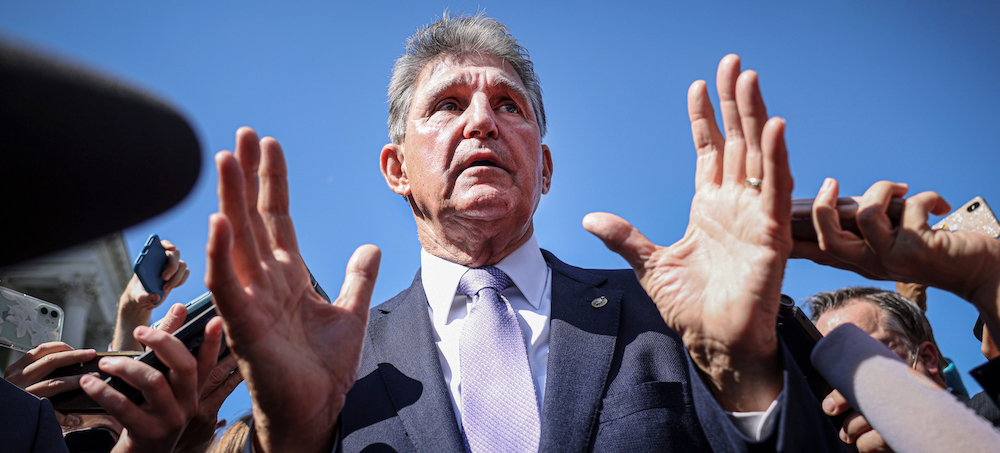Live on the homepage now!
Reader Supported News
And in doing so, they’re threatening the party’s electoral future.
Those making big plans to sell the Democrats in next year’s midterms may want to make sure legislators haven’t already cashed someone else’s checks. It’s becoming increasingly clear that the moderates who have been steadily whittling down the Biden agenda are doing so at the behest of lobbyists and corporate interests, who are powerful enough to alter the legislative agenda but cannot actually guarantee enough voters will keep the party in power after the damage is done.
We should recall that there are stark choices that need to be made. For the Democrats’ midterm plan to work, something resembling President Biden’s popular agenda actually needs to pass. As certain Senate Democrats (looking at you, Kyrsten Sinema and Joe Manchin) refuse to part with the filibuster, once the budget reconciliation bill and the bipartisan infrastructure deal get enacted, our lawmakers’ lawmaking duties will in all likelihood be done for a number of years. So there really is no Plan B: The only things that Democrats will be able to brag about for the next two elections are in these measures.
The good news is that the budget reconciliation bill is very popular with the public. The bad news is that some Democrats appear allergic to its most popular provisions. As The New York Times’ David Leonhardt and Ian Prasad Philbrick recently wrote, this aversion extends to “government action to reduce drug prices,” several tax hikes on wealthy earners, and a “proposed expansion of Medicare to include dental, hearing and vision coverage.”
Elsewhere, Reuters’ Jarrett Renshaw reported that while the “$3.5 trillion Biden proposal outlined earlier this year included free community college, expanded child tax credits and universal preschool for any U.S. citizen,” Democrats are now hard at work adding means tests and eligibility caps, sacrificing universality for the sake of satisfying budget hawks.
And, as The Week’s Ryan Cooper documented at length, a similar effort is underway for the Family Act—a simple, straightforward, and universal parental family leave measure that would “provide 12 weeks of paid leave per year for new parents, people caring for family members, or people with serious illness.” Thanks to Representative Richard Neal, the chair of the Ways and Means Committee, the original bill has become “mangled … beyond recognition” into a means-tested “nightmare of complexity” that will force families to jump through unnecessary hoops, and exclude some of the most needful families from vastly diminished benefits.
When you consider the fact that Democrats are also not likely to fully renew the wildly popular expansion of the child tax credit, the Biden agenda’s already worrying trajectory appears to have worsened considerably in a short amount of time. As Leonhardt and Philbrick note, the “well-financed, well-organized lobbying groups strongly oppose some of the bill’s major provisions,” and are a major driver of this trend. Cooper’s analysis of the state of play over the Family Act broadly reaches the same conclusion: “Some insurance companies already offer private paid leave plans, and they’ve been donating hand over fist to most Ways and Means Democrats for years, Neal included. They want a piece of the action.”
This dynamic should receive more media attention. Throughout the past few weeks, the Beltway press has focused on the intraparty tensions between a progressive coalition that’s made a lot of concessions but continues to support a bill that’s popular with the public and stands to do some material good and a more conservative faction of moderates who have been hostile to the Biden agenda. This conflict has been largely framed as a clash of competing philosophies: profligate spenders versus miserly austerians.
It’s well past time, of course, to end the practice of blindly lending legitimacy to the positions of deficit hawks. But that’s grist for another mill. What’s important to note here is that the moderates aren’t actually coming by their ideological imperatives in an honest manner. If the media wants to continue covering these internecine conflicts, they might do well to remember that only one side is acting out of principle. The other has been bought off.
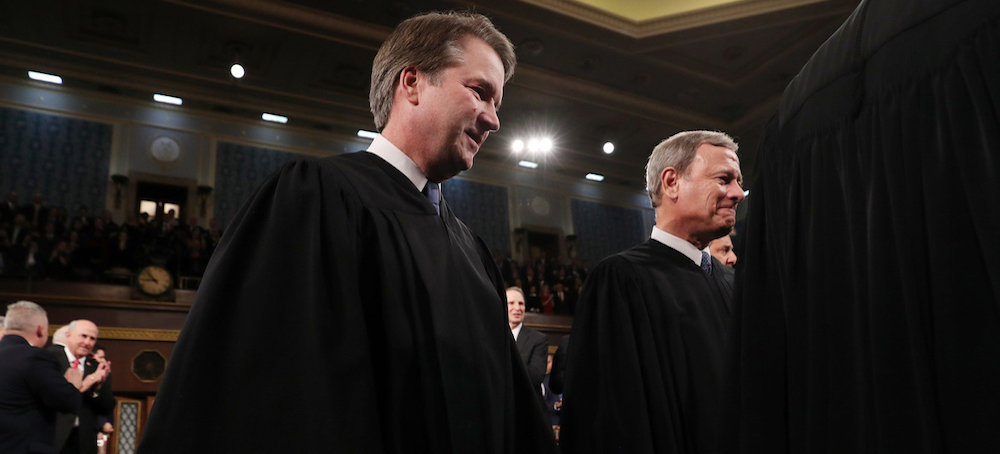 Justice Brett Kavanaugh and Chief Justice John Roberts. (photo: Getty Images)
Justice Brett Kavanaugh and Chief Justice John Roberts. (photo: Getty Images)
The docket for this term is a humdinger with major cases involving the biggest social issues of the day: abortion, guns, separation of church and state, and potentially affirmative action in higher education.
"It seems like every few years, we say we're going to see radical conservative takeover of the Supreme Court in American law," says Tom Goldstein, publisher of SCOTUSblog. But this time, he adds, "We really mean it. "
As Goldstein observes, the court has changed composition with the addition of three Trump appointees; it has six really solid conservative members and it has decided to put on the docket "front and center, massive social issues that it has ducked in the past because it couldn't get five solid conservative votes to change the law. And now it looks like it may be time."
The issues before the court are not a haphazard collection. Rather, they were deliberately selected by the court's new conservative supermajority with an eye to chipping away, hacking away, or outright overruling nearly 50 years' worth of abortion decisions, for instance, or expanding other decisions, like those protecting gun rights and religious rights.
"We may have come to a turning point"
No outcome, of course, is a sure bet, but it isn't just activists on one side or another who seem rattled. Listen, for instance, to the normally noncommittal Irv Gornstein, the longtime executive director of the Supreme Court Institute at Georgetown University Law Center.
"I think we may have come to a turning point. Within a span of two to three terms, we see sweeping right-sided decisions over left-sided dissents on every one of the most politically divisive issues of our time," he says. "Voting, guns, abortion, religion, affirmative action."
The perception of the court may be "permanently altered," he warns.
Gorstein adds: "It is all well and good for justices to tell the public that their decisions reflect their judicial philosophies, not their partisan affiliation, but if right-side judicial philosophies always produce results favored by Republicans, and left-side judicial philosophies always produce results favored by Democrats, there is little chance of persuading the public there is a difference between the two."
Abortion rights may be in peril
Three of the court's nine members have preached the nonpartisan message in speeches over the last month, but it doesn't seem to be working. The court, in two major and reputable polls, has taken a big hit. A Gallup Poll, for instance, found that public approval of the court's job performance slid to a new low of 40%, including "less than a majority of Republicans, Democrats and Independents."
Pollsters indicate that some of this precipitous decline occurred after the court allowed a Texas law banning all abortions after six weeks to go into effect. Because the law was written to make it difficult to be challenged, the five justices in the majority said this was not the time to examine it. But that did not change the fact that the court, through its decision not to intervene, allowed almost all abortions to be banned in Texas for the foreseeable future.
At the same time the court is scheduled to hear arguments in December testing a Mississippi law that bans abortions after 15 weeks. That time frame is a direct challenge to Roe v. Wade and subsequent decisions, which declared that women have a constitutional right to terminate a pregnancy up to the point when the fetus can survive outside the womb — at about 24 weeks.
There are multiple ways the court could decide the Mississippi case: narrowly or broadly. Narrowly might stave off a major backlash in public opinion. But however the court rules to restrict abortion rights, the effect of those steps could be analogous to what happens to a frog tossed into water as it heats up on a stove. He doesn't know when he's cooked.
The court revisits Second Amendment rights
If abortion represents nearly a half-century of Supreme Court precedents, guns do not. In 2008, the court ruled for the first time that people have a constitutional right to have a gun in their homes for self-defense. But beyond that principle, for all practical purposes, the court went silent. Now, for the first time in more than a decade, the court has accepted a major challenge to existing gun laws. The case was brought by gun owners against a New York law that requires a person who wants to carry a gun outside the home to get a special license, issued at the discretion of local authorities, after showing that there is a "proper cause," or need for carrying the gun. New York turned down the gun owners in this case because it said they did not have any special need to carry weapons outside the home for self-defense.
Supreme Court advocate Roman Martinez notes that the text of the Second Amendment does protect the right to keep and bear arms. But he also points to the historical record dating back to the time of the founding. New York state, he says, has "actually put forward a lot of evidence showing that really there were these restrictions on the right to carry arms outside of the home" long before the modern era.
The court is friendly to religious rights groups
After guns this term, there is religion. In particular, restrictions on taxpayer aid to religious schools. Before the court is a case from Maine that presents the issue rather starkly. Maine is a basically rural state. It has about 260 so-called administrative districts (tiny towns). Of those, more than half are too small to have public schools. But Maine law requires the towns to provide an education for all minors. Under the state law, the towns can contract with a nearby public school or private school to take their students, or the town can pay the tuition at a public or private school that a parent chooses. There is one exception. Tuition can only be paid to a nonsectarian school, so that taxpayer dollars are not used to fund religious education.
For generations, the Supreme Court did erect a high wall of separation between church and state when it came to state funding. But as the court grew more conservative, it increasingly viewed these restrictions as discriminatory.
"It's going to be difficult for Maine to make a compelling case in court that it has the kind of interest that's going to get past this nondiscrimination principle," says former Solicitor General Jeffrey Wall, who served in the Trump administration.
SCOTUSblog's Goldstein notes that the conservative justices could face competing concerns this term. One is that if public lack of confidence in the court as an institution grows, the other two branches could launch a counter-revolution to change the structure and makeup of the court. That would seem to be a long way off, for now. But as Goldstein points out, "On the other hand, the conservatives feel very strongly about this stuff. They really do think that Roe was wrongly decided, that there are too few gun rights, and there's too much separation between church and state."
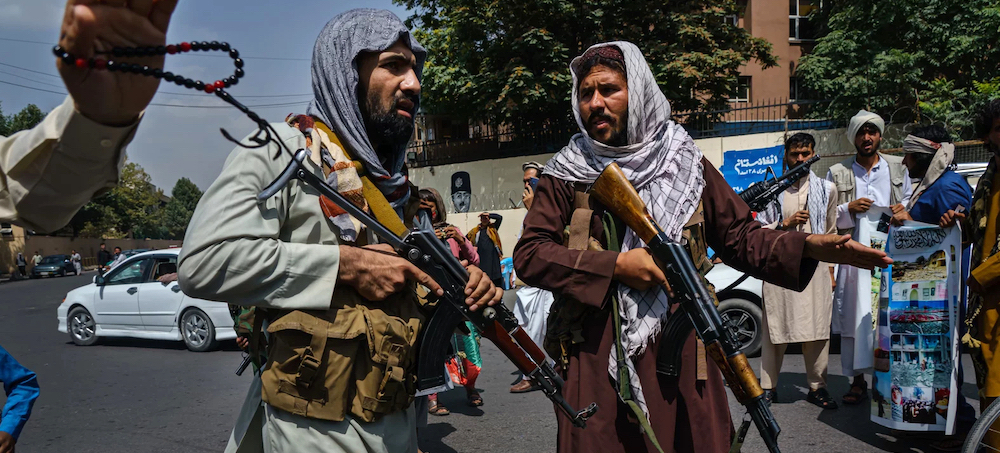 Taliban fighters mobilize to control a crowd during a rally for Afghanistan's independence day in Kabul on August 19. (photo: Marcus Yam/Getty Images)
Taliban fighters mobilize to control a crowd during a rally for Afghanistan's independence day in Kabul on August 19. (photo: Marcus Yam/Getty Images)
Something new they immediately found: The Taliban fighters who are now the policemen don't demand bribes like police officers did under the U.S-backed government of the past 20 years.
"Before, everyone was stealing our money," said Hajj Ahmad Khan, who was among those in line at the Kabul District 8 police station on a recent day. "Everywhere in our villages and in government offices, everyone had their hands out," he said.
Many Afghans fear the harsh ways of the Taliban, their hard-line ideology or their severe restrictions of women's freedoms. But the movement does bring a reputation for not being corrupt, a stark contrast to the government it ousted, which was notoriously rife with bribery, embezzlement and graft.
Even residents who shudder at the potential return of punishments - such as chopping off the hands of thieves - say some security has returned to Kabul since the Taliban swept in on Aug. 15. Under the previous government, gangs of thieves had driven most people off the streets by dark. Several roads between cities are again open and have even been given the green light for travel by some international aid organizations.
Still, there are dangers. On Sunday, a bomb outside Kabul's Eid Gah mosque killed several civilians and targeted Taliban members attending a memorial service. No one took responsibility for the bombing but the rival Islamic State group has ramped up attacks against the Taliban in an IS stronghold in eastern Afghanistan.
During their last time in power in the late 1990s, the Taliban offered a trade-off: They brought a stability Afghans desperately sought and eliminated corruption, but they also imposed their harsh interpretation of Islamic law. That included punishments like the hand amputations, executions of murderers with a single bullet to the head, most often by a relative of the murder victim and all carried out in public. Religious police beat men for trimming their beards or for not attending prayers.
In the past week, the Taliban arrested 85 alleged criminals, some accused of petty crimes, and others of murder, kidnapping and robbery, said Noor Ahmad Rabbani of the Taliban's anti-crime department.
The Taliban say they will bring back their previous punishments. The only question is whether they will carry them out publicly, Mullah Nooruddin Turabi, former justice minister and current official in charge of prisons, told The Associated Press.
Some punishments have already reappeared. The bodies of four men were hung from cranes in the center of the city of Herat, after being killed by Taliban while allegedly attempting a kidnapping. On at least two occasions in Kabul, petty thieves were paraded around the streets to shame them, handcuffed, with their faces painted or with stale bread stuffed in their mouths.
Gun-toting Taliban have taken up positions at checkpoints across Kabul and gradually some have been made to wear uniforms — the beginnings of a new national security force, officials say. For many Kabul residents — particularly the young who grew up on horror stories about the previous period of Taliban rule — the sight of the fighters is frightening as they roam the streets freely, with their signature long hair, traditional dress and Kalashnikov rifles hanging by their sides.
But so far, they appear to have brought relief from corruption. Before the Taliban takeover in August, people had to pay bribes simply to settle a utility bill. Rampant fraud in the military was one reason it collapsed so quickly in the face of the advancing Taliban. Despite the overt graft, the U.S. and Europe poured billions of dollars into the government with little oversight.
As in the past, the Taliban have turned to tribal elders to settle disputes. Last week, a group of elders gathered in a Kabul mosque to adjudicate a stabbing attack that caused minor injuries. The elders ordered the culprit's father to pay the victim the equivalent of nearly $400, enough to cover the medical expenses.
Muhammed Yousef Jawid accepted his punishment.
"It's fast, and much less expensive than it was under the previous system," he said.
At the District 8 police station, the new commander, an affable Taliban named Zabihullah, said the Taliban had fought for 20 years to bring Islamic laws to Afghanistan. "Now people are safe under our government," he said.
Zabihullah, who like many Afghans goes by one name, is from central Ghazni province, where the insurgents waged some of their most bitter battles during the last two decades.
At 32, he said he hasn't trained to be a police commander, with most of his education at a madrassa, or religious school. But Zabihullah said his years at war and adherence to the Taliban interpretation of Islamic law had prepared him.
Outside the police station gates, the line was getting longer.
Sixty-year-old Khan had come from eastern Khost province to seek Taliban help in collecting an outstanding loan. He said he supported Taliban punishments like amputations, though not for petty thieves.
He said they have brought some security "because they treat the criminal under Islamic law."
A school principal, who didn't want to give his name fearing repercussions, had come to the police station to complain about parents who are months behind on school fees.
He said he wanted to give Taliban rule a chance. Under the previous government, he was charged bribes each time he went to the police to complain about delinquent payments.
"America invested lots of money in Afghanistan, but it was a mafia that was running the country," he said.
Another complainant, who gave his name only as Dr. Sharif, had returned recently from Saudi Arabia where he had worked for several years. He had no objection to Taliban-style punishments but argued strenuously against putting Taliban leaders and religious clerics in charge of government departments.
"We need professional people ... we need economic specialists, not a maulvi who has no idea about business," he said, using a word for a Muslim cleric.
Still, he welcomed having his complaint heard without any demand for a bribe from the Taliban police. Before, police demanded a bribe just to get into the station.
"The mistake of the past governments," he said, "was that they put all the money into their pockets."
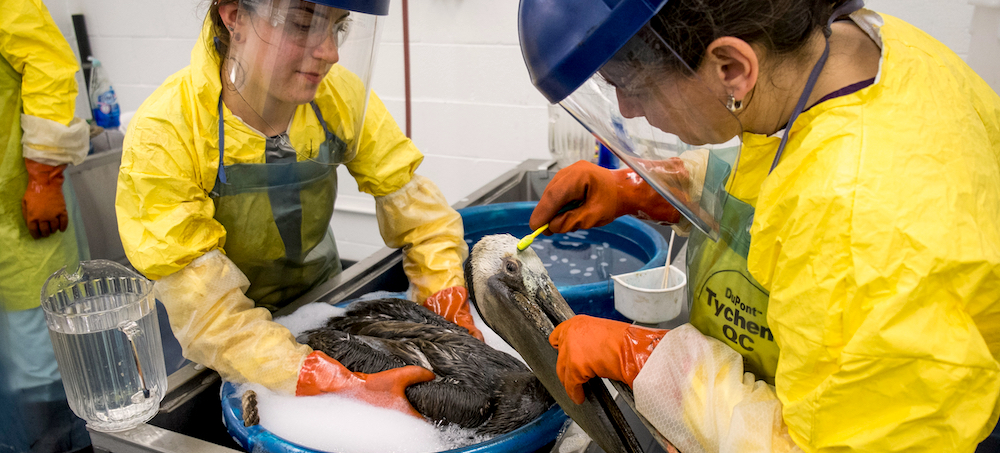 Volunteers clean a brown pelican. (photo: Joe Proudman/UC Davis)
Volunteers clean a brown pelican. (photo: Joe Proudman/UC Davis)
A brown pelican was the first casualty of the oil spill, wildlife officials said. The bird was euthanized Sunday after it was injured in the spill off the Orange County coast, Michael Ziccardi, director of the Oiled Wildlife Care Network (OWCN), said at a press conference Monday morning.
Officials captured four live birds as of Monday afternoon, Ziccardi said. A coot, ruddy duck and pelican were captured Sunday and a sanderling came in on Monday. Other oiled birds have been spotted in flight, but they’ve been difficult to catch, he said.
“When we heard of the large size of the slick with the volume that was reported released, we had grave concerns about this impact,” Ziccardi said. “In our initial assessment of the area, the number of birds in the general area seems to be lower than we had feared.”
With about 126,000 gallons of oil leaked about 5 miles off Huntington Beach, California, experts from wildlife organizations are concerned for animals.
The number killed is unknown. Wildlife experts are collecting animals as they come to shore.
“At this point, we are cautiously optimistic related to the number of animals that might be affected at this point,” said Ziccardi, who added that it’s too early to tell the impact on wildlife.
Birds come first to help, then marine life
Birds are the priority, since they’re most likely to come ashore after an oil spill, Ziccardi said.
“Birds have a high body temperature; they use their feathers almost like a dry suit to keep themselves warm in the marine environment,” Ziccardi said. “If they get soiled, their first response is to get warm as quickly as possible. That’s why they usually come ashore quickly, so that they can try to stay warm.”
The organizations rely on offshore cleanup operators who may spot dolphins or other marine life in distress, he said.
The good news for dolphins is that these mammals are “much less susceptible to oil impacts than birds,” Ziccardi said.
There isn’t enough information to speak to the long-term effects of an oil spill on marine mammals, Ziccardi said. It depends on how much oil the marine life ingest or inhale, he said.
“Just now we are starting to learn some of those long-term effects from the Deepwater Horizon oil spill more than 10 years ago,” Ziccardi said.
Oil pollution was found in thousands of fish 10 years after the disaster, according to a study published in 2020. Millions of gallons of oil spewed into the Gulf of Mexico’s waters over 87 days in that spill.
Leave the oiled animal care to the experts
OWCN is based out of the University of California at Davis (UC Davis). Its job is to respond to oil spills that affect or could threaten wildlife anywhere in the state, Ziccardi said.
The organization has more than 1,600 responders trained to go to an oil spill. Since 1994, OWCN has responded to more than 75 oil spills and cared for 10,000 animals.
Animals collected from the oily waves have a shot at recovering and returning to the wild, Ziccardi said.
“Oiling is a traumatic experience for these animals, but in our experience, as far as large-scale spills we’ve responded to, we have more than a 50% to 75% success rate to return animals back into a clean environment,” he said.
How they clean and care for the animals
Field teams are out at the site collecting animals and bringing them to a “field stabilization site” so they can give them basic first aid, Ziccardi said.
“We’re giving them warmth, we’re giving them fluids, we’re giving them a bit of time from the stress of being captured here. Then from this location we have an organized transport up to our Los Angeles Oiled Bird Care and Education Center,” he said.
When the animals are at the center, workers photograph each animal and document as much as they can. The animals are then stabilized for 24 to 48 hours, he said.
They’re cleaned of the oil before their human helpers give them “time, good nutrition, observe them carefully,” Ziccardi said. For birds, this process takes an average of 10 to 14 days, he added.
If you see oiled animals, do not pick them up. It’s not safe for the humans or the animals, Ziccardi said.
He encourages people to call the 877-UCD-OWCN hotline to report oiled animals. The organization is not taking volunteers, but instead it’s relying on its 1,600 trained responders, he added.
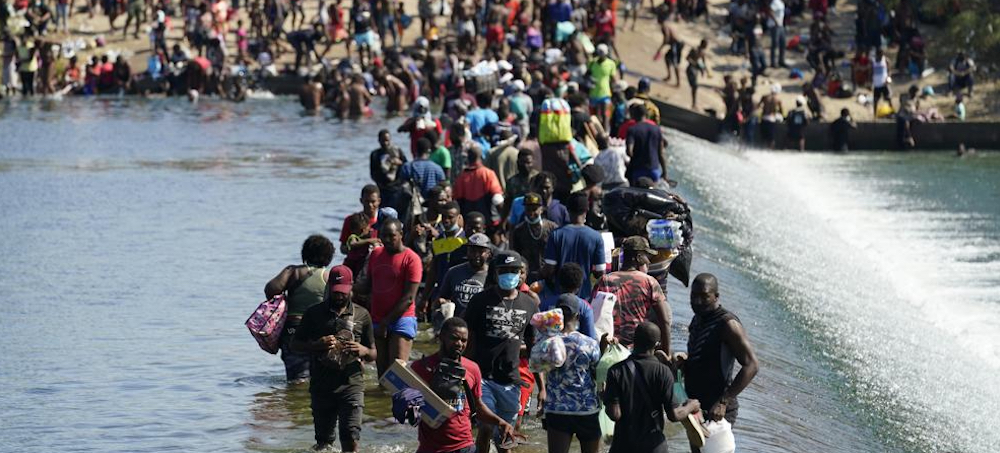 Haitian migrants use a dam to cross to and from the United States from Mexico, Friday, September 17, 2021, in Del Rio, Texas. Thousands of Haitian migrants have assembled under and around a bridge in Del Rio. (photo: Eric Gay/AP)
Haitian migrants use a dam to cross to and from the United States from Mexico, Friday, September 17, 2021, in Del Rio, Texas. Thousands of Haitian migrants have assembled under and around a bridge in Del Rio. (photo: Eric Gay/AP)
The rebuke by Harold Koh, the top political appointee in the Office of the Legal Adviser, is the latest example of passionate dissent within the Biden administration on immigration issues following the resignation of Biden’s special envoy for Haiti last month.
In an internal memo to colleagues, Koh takes aim at the Biden administration’s use of the public health authority known as Title 42, which has been invoked to expel hundreds of thousands of migrants since Biden came into office, saying it is unworthy of an administration “I so strongly support.”
“I believe this administration’s current implementation of the Title 42 authority continues to violate our legal obligation not to expel or return . . . individuals who fear persecution, death, or torture, especially migrants fleeing from Haiti,” he wrote in the memo, which was first reported by Politico.
President Donald Trump first invoked Title 42, a rarely used public health authority, to expel immigrants at the U.S.-Mexico border. Liberals decried the move as the exploitation of the global pandemic to impose hard-line immigration policies. Biden has continued the policy to the chagrin of immigration advocates and invoked it most recently to deport thousands of Haitian asylum seekers in Texas back to the impoverished Caribbean country.
In the memo, Koh said the scale of the Biden administration’s use of the authority is “startling.”
“Nearly 700,000 people have been expelled under Title 42 since February of this year, and . . . this past August alone, 91,147 were forcibly removed,” he said, citing U.S. government statistics.
When asked about the letter, White House press secretary Jen Psaki defended the continuation of the policy, saying “it remains in place because we are in the middle of a pandemic.”
In rejecting Koh’s claim that the policy is “inhumane,” Psaki said “there are several exceptions for Title 42, including those who are fleeing persecution who express a concern of fear.”
Critics have said such exceptions should apply more easily to Haitians whom the Biden administration has deported back to a country overwhelmed with an array of crises, including the proliferation of powerful armed gangs, food insecurity, the spread of the coronavirus and the aftermath of a deadly earthquake in August.
In September, Biden’s special envoy to Haiti, Daniel Foote, quit after six months on the job, saying he couldn’t be “associated with the United States’ inhumane, counterproductive decision to deport thousands of Haitian refugees and illegal immigrants to Haiti.”
Koh had been an internal critic of the Biden administration’s deportation policy for months, but the 3,000-word memo amounted to his lengthiest criticism of the policy, according to a State Department official who spoke on the condition of anonymity to discuss internal matters.
In the memo, Koh urged the administration to consider “more lawful” and “more humane” policy options, including determining whether recent Haitian migrants may have legal status and family ties in other countries where they could be sent, such as Brazil or Chile, instead of returning them to Haiti. He also calls for the immediate suspension of all Title 42 flights, “but especially to Haiti.”
Koh was appointed to the State Department in the winter and had long planned to step down this fall to take on a professorship at the University of Oxford, according to people familiar with the matter. Under the arrangement, Koh would continue consulting the department on a number of issues, though it is unclear whether the agreement remains in place following his dissent.
“I ask you to do everything in your power to revise this policy, especially as it affects Haitians, into one that is worthy of this Nation we love,” Koh wrote to his colleagues.
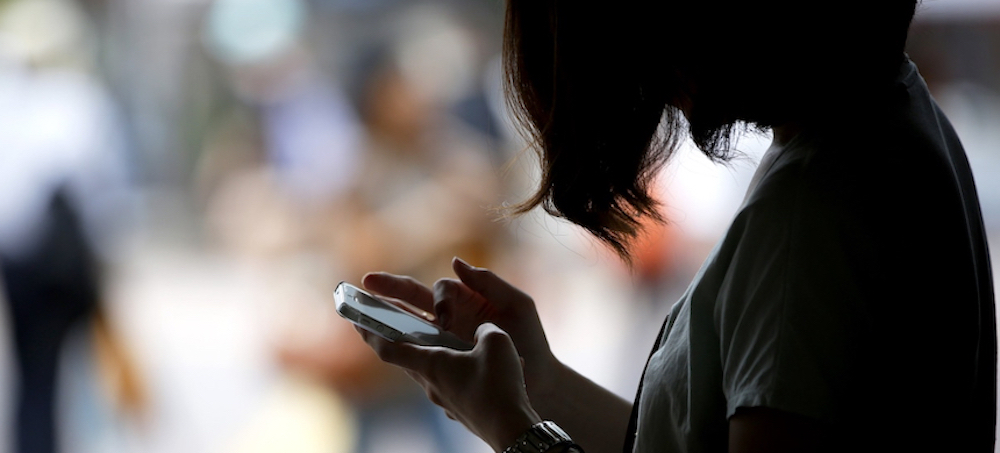 A woman uses her phone. (photo: Getty Images)
A woman uses her phone. (photo: Getty Images)
Billions of users were unable to access Facebook, Instagram and WhatsApp for hours while the social media giant scrambled to restore services
Why did Facebook go down?
Just before 5pm UTC, people began noticing they could not access Facebook, Instagram, WhatsApp or Messenger. It would be more than five hours before services would begin to be restored.
Facebook issued a statement on Tuesday confirming that the cause of the outage was a configuration change to the backbone routers that coordinate network traffic between the company’s data centres, which had a cascading effect, bringing all Facebook services to a halt.
It meant not only was Facebook gone, but everything Facebook runs disappeared too.
Others have provided a bit more detail on why Facebook vanished from the internet.
Cloudflare – which had its own recent internet outage issues – has provided a detailed explanation about what happened.
It involves two things that sort out how the internet is the internet – that is Domain Name System (DNS) and Border Gateway Protocol (BGP).
The internet is a lot of connected networks. A lot. So that means to keep order of things, you need something like BGP to tell you where you need to go. DNS is essentially the address system for the location of each website – its IP address – while BGP is the roadmap that finds the most efficient way to get to that IP address.
Cloudflare said Facebook on Monday essentially told BGP through a series of updates that those paths to Facebook no longer existed. But not just for Facebook, everything Facebook runs. That meant people trying to reach Facebook couldn’t find the path to access it.
Why were Instagram, Messenger and WhatsApp down?
All of Facebook’s services were affected, not just Facebook. It included Facebook’s own internal systems, with reports staff were locked out of offices, and could not access their own internal communications platform.
Why did it take so long to fix?
Facebook’s own internal systems are run from the same place so it was hard for employees to diagnose and resolve the problem.
As the Guardian’s UK technology editor, Alex Hern, put it on Twitter, “Facebook runs EVERYTHING through Facebook”, so the usual way you would fix a problem like this was also not working.
Facebook staff were reportedly unable to access their own communications platform, Workplace, and were unable to access their office due to the security pass system being caught up in the outage.
Facebook indicated the duration and severity of the outage meant the systems were being brought back to full capacity slowly.
How did they eventually fix it?
Facebook so far has not gone into much detail about what went wrong and how it was fixed, but there were multiple reports the social media giant sent a technical team out to its servers in California to manually reset the servers where the problem originated.
Can this sort of outage be avoided in future?
This one is fairly uncommon but not something that can be completely avoided. However, the Facebook outage, along with others including the Cloudflare outage in 2020, and the Fastly one in June, show the problems with having a single point of failure for a vast number of online services people rely on.
People rely on Facebook not only to connect with friends and family, but businesses use it to log into other services including online sales websites. In some countries, it is the dominant means of communication through services like WhatsApp. That an outage can have such a profound impact on billions of people for several hours will give some pause for thought.
Was my personal data at risk?
No more than when Facebook is up and running.
Isn’t this all weird timing for Facebook?
Yes. Facebook is not having a good time right now. Last week Facebook paused a plan to launch Instagram for kids, after leaked internal research showed the company was aware the app could affect girls’ mental health.
Then on Sunday, the former Facebook civic integrity product manager Frances Haugen went public with explosive allegations that Facebook had prioritised growth and profit over public safety.
“The version of Facebook that exists today is tearing our societies apart and causing ethnic violence around the world,” she told 60 Minutes.
How much did it cost?
We haven’t seen a cost estimate yet for how much it cost businesses who rely on Facebook. The outage, along with the whistleblower story on Sunday, prompted Facebook’s share price to drop 4.9% on Monday, causing founder and CEO Mark Zuckerberg’s personal wealth to drop $6bn, according to Bloomberg.
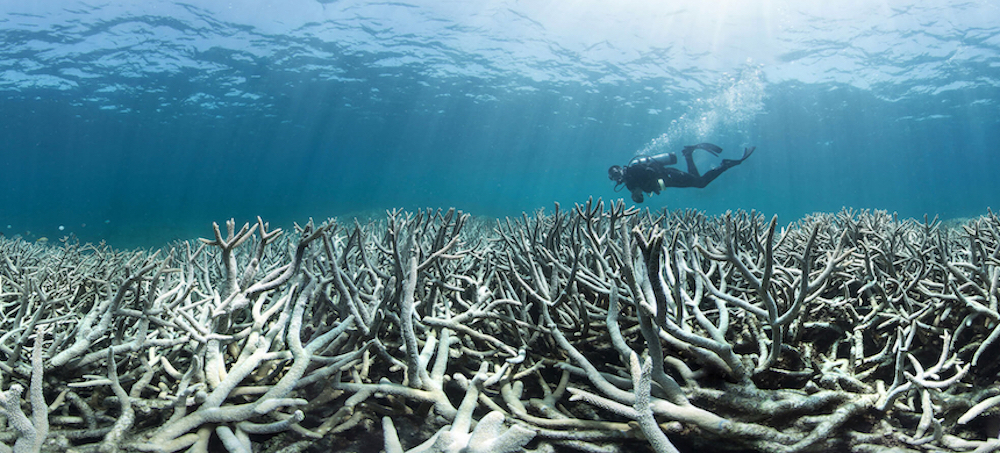 A diver swims through bleached coral. (photo: AMCS)
A diver swims through bleached coral. (photo: AMCS)
Climate change combined with overfishing, coastal development and declining water quality destroyed ecosystems home to at least a quarter of all marine animals and plants.
Corals in South Asia and the Pacific, around the Arabian Peninsula, and off the coast of Australia, were the hardest hit, according to the report which was released on Tuesday, compiled by more than 300 scientists in the Global Coral Reef Monitoring Network.
The report spanned data for 40 years, 73 countries and 12,000 sites and found the total area destroyed equal to about 11,700 square kilometres (4,517 square miles).
“Climate change is the biggest threat to the world’s reefs,” co-author Paul Hardisty, the chief executive of the Australian Institute of Marine Science, said in a statement.
Coral reefs cover only 0.2 percent of the ocean floor, but they are home to at least a quarter of all marine animals and plants.
Besides anchoring marine ecosystems, they also provide food, protection from storms and shoreline erosion and jobs for hundreds of millions of people worldwide.
The study looked at 10 coral reef-bearing regions around the world and found that reef loss was mainly the result of coral bleaching, but also overfishing, unsustainable coastal development and declining water quality.
“There are clearly unsettling trends toward coral loss, and we can expect these to continue as warming persists,” Hardisty said.
Oceans absorb more than 90 percent of the excess heat from greenhouse gas emissions and bleaching takes place when corals, under stress from warmer water, expel the colourful algae living in their tissues and turn white.
Cautious optimism
A single so-called bleaching event in 1998 caused by warming waters wiped out 8 percent of all corals.
“Since 2009 we have lost more coral worldwide than all the living coral in Australia,” noted UNEP Executive Director Inger Andersen.
“We can reverse the losses, but we have to act now.”
The UN’s climate science advisory panel, the IPCC, projects with “high confidence” that global warming of 1.5C above preindustrial levels will see between 70 and 90 percent of all corals disappear.
In a 2C world, less than 1 percent of global corals would survive.
Earth’s average surface temperature has already increased by 1.1C above that benchmark.
The report titled: Status of Coral Reefs of the World: 2020, found reasons for cautious optimism.
“Some reefs have shown a remarkable ability to bounce back, which offers some hope for the future recovery of degraded reefs,” Hardisty said.
East and Southeast Asia’s so-called Coral Triangle, which contains nearly 30 percent of the world’s coral reefs, were hit less hard by the warming waters and in some cases showed recovery.
This resilience could be due to species unique to the region, potentially offering strategies for boosting coral growth elsewhere, the authors said.
Follow us on facebook and twitter!
PO Box 2043 / Citrus Heights, CA 95611

